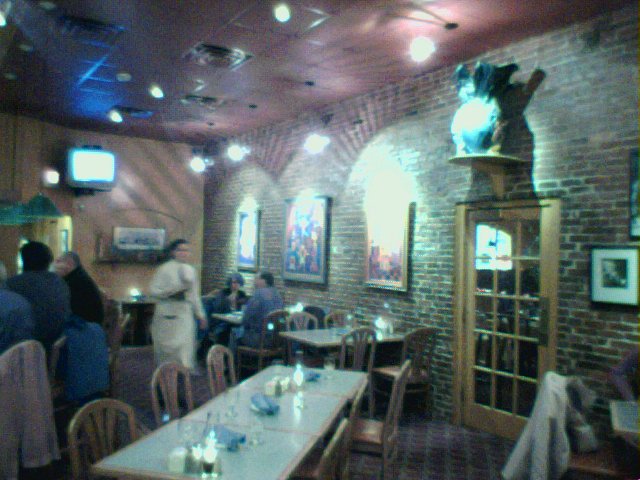

|
Player's Journal 2003 2015 2014 2013 2012 2011 2010 2009 2008 2007 2006 2005 2004 2003 2002 12/26/2003 Resolutions
New Year's "resolutions" are mis-named. They are not resolved, but suspended, pending resolution in the new year. I try to avoid them. But the end of the year is a good time to reflect, and make some plans. It was a good year. I enjoyed playing solo gigs. I had three sort-of-steady gigs: All Asia in Cambridge, Chai in North Andover, and Michael Timothy's in Nahsua. Of those, I think only Michael Timothy's will continue, but that's fine, since it's the best gig imaginable. One weekend early in this month I had four gigs, but since then none, and nothing on the books for next year. So I need to make a push to get more gigs. In the past year I've sent PR packages to about 50 restaurants and bars in New England, and I only have a few on my list that I have not yet tried. Maybe one I've sent to in the past will suddenly decide they need a solo guitar player. Other than that, I just have to hope that I'll find some new venues I haven't thought of before. 12/24/2003 Chestnuts I picked up my guitar tonight while Mal was cooking dinner. I usually practice without the amp, but tonight I plugged in. My home office is right next to the kitchen. I had a plan. I played "The Christmas Song (Chestnuts roasting...)." When I finished, she came in, smiling. She said, "You're playing Christmas music! You never play Christmas music!." It was a gift. She said, "I have to call Sheri. You have to play it for her." Sheri, our older daughter, lives upstairs. Mal called, and got her fiance, Jason, on the phone. She held the phone up to the guitar and I played Jason a few bars of "Chestnuts." Then he put Sheri on the phone and I played her a few bars. It was great fun. Best kind of Christmas card. 12/22/2003 By Design Sometimes I try to design melodic fragments in my head. I say design, because in these instances I think of it much like designing a code fragment for a piece of software. I have a starting point and a destination, and I try different "algorithms" to get from the former to the later. The other day I came up with one such design. I was thinking of the changes to "Here's That Rainy Day" and thought about a simple medody that used an arpeggio for the opening chord, but I also wanted to try to incorporate the minor third of the chord, since that note is so important to the tune. Click here to see the motif study I designed. Sometimes students ask, "Were you really thinking about all that when you wrote this?" No. I wrote a very bland, predictable four-bar passage, and then noodled with it until it sounded good. The explanation is after the fact, but I think it represents some of the underlying principles that make the passage sound good. 12/14/2003 Take Note 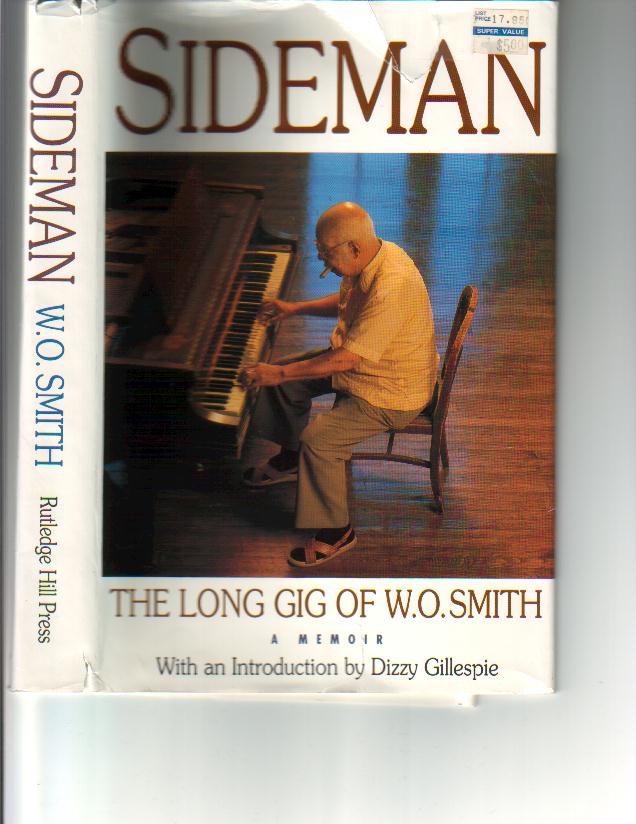
I've always felt that reading musicians' autobiographies was important. I just re-read Sideman. I love the subtitle: "The Long Gig of W.O. Smith." Here's the book jacket. Here's an excerpt: The mid-thirties musical picture in Philly as far as black musicians were concerned included about four major groups. Doc Hyder and Jimmy Gorhan had the two prestige big bands--twelve to fourteen pieces--and they played the major dances and the large dance halls. Harry Monroe had a smaller eight-piece, so-called "society" band. His group played primarily for the black bourgeoisie, which meant that they played less but got paid more. They played show tunes, the waltz, and things like that. Most of the sidemen had good jobs at the post office or in the city civil service. They were good-to-excellent musicians. Like the Jimmy Gorham and Doc Hyder groups, they were the older and established musicians. Monroe's band paid eight to ten dollars a night. The Gorham and Hyder groups paid four to five dollars. The younger groups got a percentage of the house, maybe, or two to three dollars--maybe. None of the younger musicians would play for Monroe, even for the extra money, because of the sedate music. There was another band of Dixieland led by George Baquet from New Orleans. Most of us knew little about this group because they played the white hotel and club circuit. They probably paid the most. The younger arriving musicians like Dizzy Gillespie, Charlie Shavers, and Jimmy Hamilton were less concerned with how much they were paid than with not compromising on the quality of pure jazz. The two dollars, or more likely a percentage of the attendance, was satisfaction enough for being able to play our standard of music. I wish the younger musicians of today would take note. 11/25/2003 One Thing 
Music can say four or five different things at the same time, and can say them in such a way that the different things combine into one thing. Aldous Huxley, "On Art and Artists," Preface Huxley goes on about "simultaneity of incompatibilities." That has always, to me, been one of the beauties of art. I think that's where subtleties come in. An awareness of incompatibilities. Like the cold/warm contrast I talked about in my last post. But awareness is only the start. After that, there's the decision -- whether conscious or not -- about how to bring out that contrast. I have an arrangement on my site for a comping part on "How Insensitive." When teaching this, I always emphasized the movement of the bass note from Eb to E. It's only a half-step up, but it's the first E-natural in the piece. Don't make it sound too easy. Up until that point, the bass motion has been down, sad, resigned. Your attack on that E-natural speaks volumes. But it must be subtle enough that the piece still, in Huxley's words, can "combine into one thing." Some players use the open E string at that point -- just because it is there. 11/23/2003 Revisiting pima My right-hand technique for soloing and comping is pick-and-fingers style, sometimes called hybrid style. Rather than play fingerstyle, without a pick, I use the pick and fingers 2, 3 and 4. This is a fairly common technique. In classical finger style, the fingers are marked p i m a, with the thumb being p, the index finger i, the middle finger m and the ring finger a. I think of it this way: pick (thumb and index finger) p, middle finger i, ring finger m, pinky a. One of the things I did to develop flexibility with this technique was to practice some Carcassi and Sor etudes with it. That way I could interpret the pima markings with my approach. Lately I've been feeling that I'd like a little more control of my pinky, so I've been doing a few exercises. Heres one: 
The voicings involve a half barre with the first finger of the left hand. All the notes should be sustained. It's especially important to get the A and G to ring together, to bring out the dissonance of the major second interval. There are ways to notate that more accurately, but I've just notated a quick sketch. I think of the sound as a vibraphone with the pedal down. I found the voicings years ago when I was working on a solo arrangement of "How Insensitive." These chord occurs where the lyric says "How removed and cold I must have seemed." I liked the contrast between the warmth of the chord and the coldness in the lyric. The challenge is to achieve an evenness of tone on the melody notes. Since the ring finger is larger and stronger than the pinky, I have to supress the ring finger a little. The angle of the finger placement on the string, with the right ratio of flesh to nail is also important. P.S. added 11/24/2003: I just noticed from Robert Conti's web site that he plays exactly the same voicings on "How Insensitive." 11/11/2003 Dynamic Duke 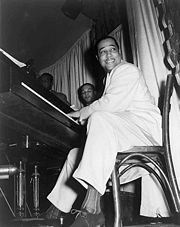
Schuller, Gunther. The Swing Era I have mentioned Ellington's use of dynamics in "Moonglow." To put this in context one must realize that dynamics have always played a minor role in jazz, even to this day. Thousands of jazz musicians and tens of thousands of performances, many of them perfectly acceptable in all other respects, have made no use whatsoever of dynamics either to achieve contrast or to use as an expressive or decorative device, and least of all, have they been used as a means of delineating structural aspects of a piece. Much of this disregard of dynamics resulted from a lack of technical instru-mental control. Some of it represented a general unawareness of the multiple ways in which dynamics can function in music. Indeed I am certain that dynamic differentiation was considered by many jazz musicians as contrary in spirit to the hell-bent spontaneity of "hot jazz." It was considered somehow effete and intellectual to control and modify expression through dynamic differentiation. It was considered "arty" and "pretentious," and--"worst of all"--derivative of classical music. Typically Ellington ignored such narrowing injunctions. p. 67 11/10/2003 Melodic Chord Solos The terms "chord solo" and "chord-melody" too often lead to misconceptions. What they refer to is a harmonization of a melody, that is, a melody supported by chords (and maybe a bass line.) The melody is the most important part. But too many guitarists focus on the chords to the detriment of the melody. They break the melodic phrase in order to get to a chord. The result can sound something like this: "Look at (pause) me, I'm as (pause) helpless as a (pause) kitten up a (pause) tree..." I go to considerable effort to play unbroken phrases when I'm playing "chord solos." My mother used to have a saying: "A man on horse back wouldn't notice." Meaning, of course, that someone passing by quickly would not notice. I think few people, even accomplished guitarists, listening to me would really notice that the melodies, for the most part, are smooth, unbroken. Too many people on horseback these days. 11/01/2003 Find Myself Playing 
I only had a few minutes to pick up the guitar tonight. I played through my solo arrangement of "My Foolish Heart." Once again I was not happy with the turnaround (which I also play, with a slight modification, as the ending). So I worked on it for a while. I like what I came up with. Click here to see the voicings. As with so many things, the phrasing is all important. Man must endure Their going hence, even as their coming hither; Ripeness is all. ~ William Shakespeare, King Lear. Act V, scene ii A ritardando on the dominant. I find myself instinctively playing the pedal Bb with the third finger of my right hand, rather than my pinky, to get a fatter note. At the end of the tune, I also find myself playing the final Bb bass note with an upstroke of the first finger of the right hand. (I don't even know what I do with the pick at that point, since I usually hold it between thumb and first finger.) This gives me a sound closer to the sound of an upright bass. 10/31/2003 Distortion and Correction 
Menuhin, Yehudi Violin and Viola One important method of perfecting interpretation is what I call the process of distortion and correction. Essentially it consists of practising the work in this sequence. First decide which notes are the most important, which stresses should be underlined, where minute alterations of volume and speed would be called for, and exaggerate them. Then eliminate them, smooth them, plane them down, work at them with metronome, so that nothing remains obvious, nothing shows. The public, the listener, cannot say: 'He's deliberately twisting the phrase in this or that way', because what remains is essential and discreet, and reveals the line and the shape, the living ebb and flow. Discretion is so important in all works, event the most wildly romantic. If you hear the great Russian musicians perform Tschaikovsky--and to what fantastic effect--you realize that the true way of making music--even with Tschaikovsy--is not to exaggerate but to allow the flow to carry you and to build up, without willful twisting or distortion. A greater climax can be better built up by a relentless, continuous motion than by small excursions which lose the accumulated tension and dissipate the mood instead of allowing it to follow its creative course. I believe that the play between freedom and discipline, between distortion and correction, must continue. There is no such thing as settling for one or the other. The one is inspiration and the other is form, and meaning, and elegance, and presentation. The one is wild and the other controlled, and they must continually be put in balance. The wild must not be allowed to erupt, and go off the handle, and carry us to extremes, nor the controlled be allowed to deaden, kill, make rigid and make useless our efforts at communication. The one is the fuel and engine, the other the driver or the pilot. The one is the wings, the other the eyes and brain of the bird. pp. 105f I remember a clinic where Gary Burton talked about how he developed his phrasing. He said he played a bebop tune and recorded it. When he listened back, it just didn't sound like the records he'd heard. So he played it again, accenting the certain notes, recorded, listened back. Still didn't sound right. He tried again, this time accenting the notes even more. Still not right. So he thought, "Ok, this time I'll accent the notes so much that they will sound really ridiculous." He recorded, and listened. It was just right. 10/25/2003 Little Harmony I went out to a local club for the Jazz Brunch today. There was a guitar and upright bass duo. We had to stand for a while at the back of the room, waiting for a table. I noticed that the music sounded empty. At first I thought it was just the absence of drums. Then I thought it was due to the fact that the guys were playing pretty soft, it was a big room, and the crowd was talking pretty loud. After a while I realized it was none these. The guitar player was not playing any chords! He was a good soloist, and did a nice job on the melodies ("Nancy with the Laughing Face" was especially well done) but he played almost no chords, and I felt the lack of harmony. It wasn't just on a few tunes, either. We were there for about two hours. In that time I heard him play a grand total of maybe a dozen chords (aside for his comping behind the bass solos) and none of them were under melody notes. What a strange approach! I thought of some lines from a Wallace Stevens poem:
On this occasion the imaginings (the harmonies) were too concealed, and I sighed for so little harmony. 10/25/2003 The Lost Art of Reading Liner Notes 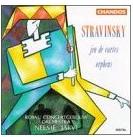
In the days of vinyl records, once you'd put the LP on the player, you'd have a large piece of cardboard in your hand, the back of which was covered with print, and it was natural -- and enjoyable -- to read that print while listening to the music. This print was known as liner notes. Much of the writing there was good, some was educational, and a few gems were deeply influential. This morning as I was about to do my weekly review of my many To-Do lists, I wanted some music that was imaginative and inspiring. I put on a CD of Stravinsky's "Jeu de Cartes," and, struck by the cubistic image on the cover of the insert, I decided to take a few minutes to read the liner notes. I won't take the time to reflect in writing on what I read, but I did want to make a note on this lost art. The insert for my Act One CD contains one of my original poems (it's elsewhere on this site, as well) as does the insert of one of the TL Duo CDs (also on this site). I wonder if anyone ever read them? I read with great delight Willie Ruff's liner notes to the "Breaking the Silence" Mitchell-Ruff CD. I'll have to write about that. Later. Right now, back to the "Game of Cards." Stravinsky got me wondering what I might grab from my journals for this post. The first thing I found was this: **Oedipus short story -in Unanswered Question, Bernstein says something about Stravinsky--"that colossal Dad," as Auden called him, and re: Schonberg and Stravinsky: "the loss of both big Daddies." Intersting, since the second piece on the CD, which I was listening to while I searched my journals, is "Orpheus." Myths. The reference in my notes is to a short story I started many years ago. "Daddies." John Neves used to talk about "the Daddies of the instrument." I wonder if Auden's quote is the source of the bebop term "Daddy" and "Daddy-O." Also serendipitous, the next journal entry was this: **Master class I saw John on the street today. He had a fat bundle of books under his arm. In my last years of studying with him, he was a student at Berklee. The reference is to John Neves. "Master Class" refers to a short story I stared, about studying with John. I guess I have a lot of loose ends to tie up. 10/24/2003 Coffee Shop Exercises I used to carry my laptop computer with me a lot. I had MusicPrinter Plus on it, so I could write music while sitting in a coffee shop, and even hear it back through headphones. These days I carry my Palm Zire 71. Even though there are a few music programs available for it, and it has a headphone jack, I don't write music on it. That is, I don't notate music on it. But I have sketched out some exercises. Here's one:
2nd, 4th - don't land or start on avoid note. ascending leap, descending line: C D G, A B E, G A D, E F B, D E A, C D G. lines: first notes: C A G E D G last notes: G E D B A G descending leap, descending line: G D C, E B A, D A G, B F E, A E D. I made that text entry many months ago, and just tonight I got around to notating it in MusicPrinter Plus. What it means is this: start on the root of some scale; move a second, then a fourth, avoiding avoid tones; make notes move up, but move the starting notes down. Click here for the music notation. Example 1 is the sequence in 12/8 time, with a little "tail" added to create a more melodic ending. Exercise 2 is the same thing with a different rhyhtm in 4/4 time. Exercises 3 and 4 are transpositions to Eb. Notice that I've suggeste positions to practice these in, but there are lots of interesting phrasings to be had by slurring some of the notes and moving around the neck. Maybe I'll explore some of those in another journal entry. It's interesting that Exercise 1, inadvertently, contains a compound line, as I've indicated in my "first notes" and "last notes" notes. There are some further exercises to be derived from those, so I'll have to come back to this. Also, I need to notate the "descending leap exercise." Surprising what you can discover in a coffee shop! 10/16/2003 Off Bass The producer of the Red Sox video (see Boston Bassed, below) did not want the music to sound like "New York New York" because he was concerned about licensing issues. He had directed the singer to not sing it like "New York." But it was pretty close. To cover up, the keyboard player played some fairly unrelated stuff. Nothing that I could easily put a bass line to. After a while I reminded them that since this was a parody, they didn't have to worry about rights. Anyway, there was nothing for me to do, so I went back downstairs and put my bass back in the closet. I guess after a while, they decided to let the piano do something close to "NY". It was weird, anyway, since the dubbed a male singer track with a female lead. The result was pretty humorous. To see the Quicktime video, click here. 10/11/2003 Boston Bassed Jason is filming a spot that may be aired on Fox TV, a take-off on "New York New York" about the Red Sox in the playoffs with the Yankees. He's asked me to add some bass lines. I dug out my Travis Bean fretless bass. 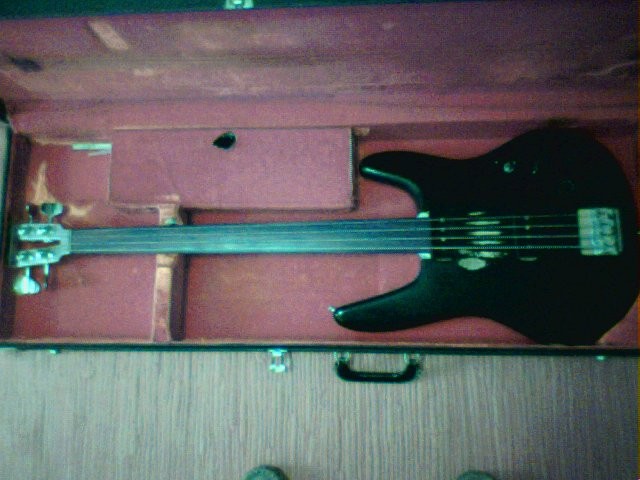
I dug the bass case out of the closet. The dust on the case was a quarter-inch thick. I hadn't played the Bean since we moved into this house three years ago. It's a great instrument. The neck is aluminum and goes most of the way through the body. It's similar to a Kramer, but the headstock is different. 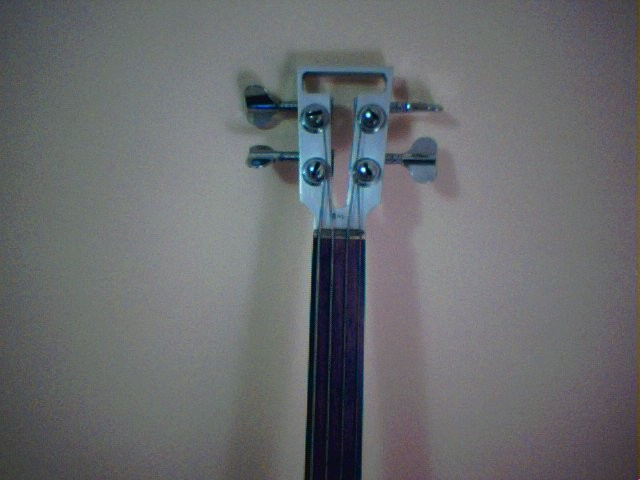
What differentiates the Bean is that the end of the headstock has a piece of metal going across, forming the characteristic "T." I've been told this gives better structural integrity to the neck, since on the Kramer the metal arms that the strings attach to are under more stress from the strings. I don't know if that's true, but it's an interesting theory. The Bean has a great sound: long sustain and a rich tone. Years ago I played upright bass (and took lessons with John Neves, which is a long story for another time), and I've always tried to get an acoustic bass sound out of the electric. At one big band rehearsal where I played the Bean, one of the older players came up to me on a break and said, "That's the closest to an acoustic sound I've ever heard out of an electric." That's what I like to hear! 10/04/2003 Jes' Fine I was listening to Wes Montgomery at dinner tonight, and it reminded me of a story. In 1969 I was working with a band called The Heat Palace at a Boston club called The Cable Car. It was a white band, but most of the music we played was by black musicians: Otis Redding, Muddy Waters, John Lee Hooker, and so forth. The '60's were a pretty racially tense time in Boston, but in this club there was a mixture of black and white fans, everyone loved the music, and everyone got along. We got to know a few black folks who dug the band, and one night after the gig they invited us to come over their place for a drink. When we walked in, there was a Wes record playing. It was the first time I heard Wes, and I stopped in my tracks. I said, "I wish I could play like that." Our host said, "Don't you be sayin' that. You play jes' fine, jes' fine. Now that's Wes and Wes plays like Wes, an' you're you, an' you play like you, an' you play jes' fine. So don't you be sayin' that." 10/02/2003 Lists I keep a Gig Checklist on my Palm. Before each gig I make a copy of it, and delete any items that don't apply to the particular gig, and add anything that's special for a given gig -- like a 300-foot extension cord. I refer to the list as I load the car and check off items as I go. Before leaving for the gig, I take one last look at the list to make sure I haven't forgotten anything. Many years ago I actually left for a weekend gig out of town and left my gig clothes hanging in the suitbag near the front door. I got quite a few miles before I realized what I'd done and had to turn around and go back. I'm a fanatical list maker. I've always believed that lists have a way of getting themselves accomplished. I keep a list of tunes in progress. Here's what's on it right now. I check off the tunes after I've played them on a gig with some feeling of satisfaction -- actually a little longer than that. Having some completed items on the list reminds me that I can get these things done. Nothing succeeds like success. It's interesting that "Dolphin Dance" is on the list, considering that it's on my solo CD. That cut was recorded live at a private party, and I was happy enough with it -- in spite of a couple of rough spots -- to put it on the CD. But I haven't played it much since then, so it needs work. "Dolphin Dance" reminds me of a story. (Anyone who's been in one of my classes knows that everything reminds me of a story.) I was playing a solo gig in a bookstore on Cape Cod. A couple of women were sitting at a table nearby, listening closely. One of them said, "Would you play 'Dolphin Dance?'" I was flabbergasted! No one had ever requested that tune. How did she know that I knew it? After I second I realized that my CD was sold in that store, so she'd probably heard my version of the tune. I played it, and it came out well. After I finished, the woman took a deep breath and said, "Beautiful chords." 09/26/2003 Practicing Only Tonight as I was practicing I thought of something Dave Liebman said at a Berklee clinic many years ago: You are never praciting only scales, or only arpeggios. You're always practicing tone, time, intonation, phrasing. You may be practicing bad tone, time, intonation, phrasing... 09/22/2003 A Good Listen My apologies to anyone who has visited my Player's Journal recently and been disappointed by finding nothing new. I know from the many emails I receive that there are quite a few people who visit my site frequently and who look forward to reading something new. I always look forward to writing something new, or to making my old notes new by posting them here. But for the past few months I have been too busy with software development to post to my Player's Journal. More's the pity. Tonight I was writing in my personal journal on my Palm, and I made this observation: Given the tools we now have, is there more good writing out there, or just more writing? Lots of blogs, but almost none that I want to read. I was thinking about tools like the Palm, various word processors, Instant Text, and other technologies that allow us to write more words, faster; and tools like HTML and the Internet that let us share those words. But with all that, I still find myself longing for what my grandfather would have called "a good read." And so it is with music. With all the learning tools that are out there -- CDs, DVDs, books, software -- it seems we are producing more notes, and sharing those notes more widely. Yet with all this, I find myself longing for "a good listen." 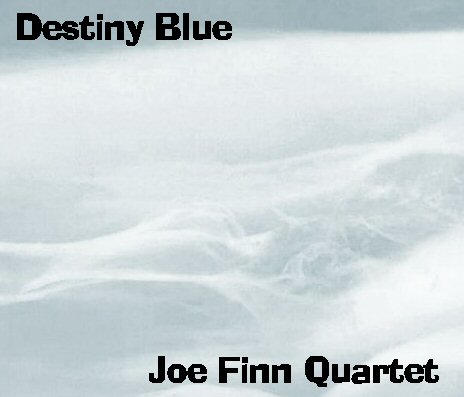
Every once in a while a good listen comes along. Sometimes it's only a few bars long; if I'm lucky, a whole tune. Joe Finn's lastest CD, Destiny Blue, is a good listen. Joe takes a refreshing approach to "Body and Soul", making it an up-tempo Latin tune. As I listened, I thought of the lyrics, and it seems to make sense at an up tempo, whereas other ballads, like "Here's That Rainy Day," do not. Joe's statement of the melody on "Upper Manhatten Medical Group" is also refreshing, mixing harmonized melody with octaves and range contrasts. His octaves at the end of his solo on that tune are a treat. Yes, I can always count on Joe Finn for a good listen. 08/29/2003 Too busy I've been too busy this past month to enter anything into my gig journal. I wish I could say that I was too busy with music, but that's not the case. I've been too busy with my day job. But I do have some thoughts in mind that I want to enter, retrospectively, in my player's journal. After Labor Day. Labor of love. 07/18/2003 Memorable 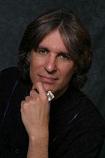
The following is a copy of an email I just sent to Howard Levy. (www.levyland.com) Howard, About 10 years ago, when I was teaching at Berklee, I was about to get on the elevator to go to a clinic by a harmonica player I'd never heard of. As I got on the elavator, I heard one student tell another, "Matt Glaser says Howard Levy is the best musician there is!" I was skeptical. An hour later, I was no longer skeptical. In 25 years of teaching at Berklee, I heard a lot of amazing clinics, but yours was one of the most memorable. During the '60's, I played with Little Walter, and played venues with Paul Butterfield, and so forth. I thought I knew something about harmonica. But what I heard come out of your harmonica in the Berklee recital hall was hard to believe. I remember you saying, "I try to play lines that will make jazz players say "Oh, Yeah!" and make harmonica players say, "How does he do that?" You had John Arcaro on piano, and you asked him to play a pedal tone while you improvised in various modes. John started playing chords, and at one point you said, "No chords, just a pedal!" I quickly understood why: I was amazed by the harmonies you brought out of your instrument. Tonight I was listening to a CD by a Brazillian singer, who is very good, but not great, and I was thinking, "What makes the difference between a performance that is very good and one that is great?" Of course, even after 40 years in the business, I do not have an answer. But for some reason, your name came to mind. I went to the computer and "Googled" you. Found your site, and was delighted. I'm looking forward to discovering more of your music. I love the "Levy Logs," too. Thanks for making memorable music. Steve 07/14/2003 Joe Finn On vacation, I met Joe Finn at our hotel room at the Roosevelt Suites in Saratoga Springs. We had exchanged some messages on the jazz guiter newsgroup, but we'd never met. I had my Peavy amp set up under a table at one end of the room, and I had my guitar out, so when Joe came into the room, he commented on what an unusual-looking guitar it is. I mentioned that I've owned it for 35 years, and Joe commented, " It must be used to you by now." We chatted while Joe set up his guitar -- a beautiful Heritage hollow-body. He plugged in to the Peavey and played few chods and licks. I was immediately struck by the warmth of his tone, the fluidity of his lines, and the lush fullness of his chords. We jammed and chatted for a couple of hours. We both love the same jazz standards, so we had fun sharing our interpretations: "Green Dolphin Street," "No Greater Love," "Another You," "How Insensitive," and many more. Joe is an accomplished jazz player with a great sense of time and a seemingly inexhaustible supply of solo ideas. He knows how to develop a motif, and how to build a solo. His octaves are amazing -- even better than Emily Remler's, I think. Joe's comping is inspiring. He sometimes comps with his fingers, and that can has the potential to create an overly dark tone, but Joe gets all the overtones ringing, so his comping is a rich and solid foundation. Our guitars blended well, and I think we were both delighted by the sounds we were discovering. Meeting and jamming with Joe was the musicals highlight of my summer. He's an artist and a gentleman -- and how rare a combination that is! 07/06/2003 Act Two - In The Wings For the rest of the summer, I'm on "unpaid sabatical" from my day job. So I have some extra time for music. For years I've been wanting to record Act Two. It would be a solo CD and a duo CD. That is, I would records duets with myself. These are, mostly, original compositions that I've written over the past 30 years. I might include a standard or two. Now I have some time to work on the recording. We'll see what develops. 06/23/2003 Dynamic I was listening to a Mal Waldron cut the other night and I was struck by the wide dynamic range he used on some phrases. It got me to thinking that there is a drawback to playing as many background music gigs as I do: I've gotten in the habit of limiting my dynamic range. So I'm in danger of losing the skill of controlling dynamics. The noise level of crowds at parties swells and ebbs in unpredicatable ways. It always seems that just when I decide to use a higher dynamic level on a phrase, the crowd suddenly becomes quiter, and I start to feel like I am being obtrusive. There's really nothing I can do about that. But, at least while practicing, I need to keep working on dynamic range. 06/21/2003 Cruising I have a short gig tonight. The CEO my company is throwing a party on a boat, cruising around Boston Harbor. I've offered to play a set while people are boarding. After that the DJ starts. Since many of the people invited are Indian, the DJ will be playing Indian pop music. Should be an interesting contrast. 06/16/2003 Mister Saturuday Night I often practice on the enclosed front porch. There's a doorway from outside to the front porch, and two doors from the front porch: one to the downstairs, where my wife and I live, and one to the upstairs, where my daughter Sheri and her boyfriend Jason live. So Sheri and Jason, and their friends, often pass by as I'm practicing. Yesterday Jason said to me, "Oh, the other night on the porch you were playing 'Mister Saturday Night.'" I was confused. I don't know a tune by that name. Then it hit me: Missed the Saturday dance. Could have gone, but what for. Couldn't bear it without you. Don't get around much any more. I always learn the lyrics to tunes and the lyrics are always on my mind while I play. Every tune has a story to tell. Thinking about the lyrics helps me to tell the story. Otherwise, it's just notes. 06/14/2003 Howlin' I was practicing guitar on the front porch tonight, playing "The Nearness of You" in Db. A fire engine went by, and, as always, the siren caused the dog across the street to begin howling. He was almost in my key. Thus I discovered that his howl is a long glissando from almost-Gb to almost-Eb, down, then up, then down again. I took this as my cue to end the set, put my guitar up for the night, and go have a glass of wine. 06/08/2003 Set list
For tonight's gig at Michael Timothy's, I'm going to try something different: a set list. I usually just pick tunes as the mood hits me, but I often find that while playing one tune I'm trying to think of what the next tune will be, and that breaks my concentration. If I try to decide between tunes, I feel like that allows too much silence between tunes. So I'll see how this goes. 06/01/2003 In it's new home When we got home from Cape Cod, we hung Allan's painting on the long wall in the dining room. Perfect. 
05/31/2003 A Different Kind of Composition We're spending the weekend with our friends Bernie and Allan, on Cape Cod. They are long-time friends (Bernie introduced me and my wife thirty-five years ago), and they are big fans of my playing. We have a tradition of having the cocktail hour in their sunroom.After we all chat for a while, I pick up my guitar and play some tunes while the conversation continues. Occasionally Bernie or Allan will pause to acknowledge a tune they recognize -- "Girl From Ipanema," or "Satin Doll." I always make it a point to play Allan's favorite song, "Moonglow," and I play "Greensleeves" for Bernie, though last night that tune was a little ragged because I hadn't played it since Christmas. Last night we had quite an extended cocktail hour, and I actually played two "sets." I was glad to do it, because I'm trying to get in shape for next week's gig, and because I knew my friends wre enjoying the music. At one point Allan asked, "You usually play that guitar amplified, don't you?" I was playing the Aria acoustically. I said I usually played it amplified. Allan said, "It sounds good in here." It did. Allan designed the sunroom as an addition to their house. It's 14 feet by 16 feet, with a 12-foot cathedral ceiling. There are large windows along three sides. Most of the furniture is wicker, so that absorbs some sound and bounces the high frequencies a bit. The floor is a textured ceramic tile, so the sound bounces a bit between the ceiling and floor. All in all, it has just enough reverberation to be a great room for acoustic guitar - even my thin hollow-body. The down side is that there is just enough reverberation to make speech a bit blurry. If I played amplified in there, conversation would not be possible. I suspect that even my full-hollow-body Guild would be too much for the room. We had planned on my playing at this evening's cocktail party -- for the "unveiling." But it turned out differently than planned. Still good, but different. We had commisioned Allan, about a year ago, to paint a picture for us. In his retirement, Allan has taken up painting, and he is quite good. We wanted a painting with a southwestern theme, and particular colors to blend with our dining room. Allen usually paints Cape Cod scenes: boats, water, marshes. He sometimes works in watercolor, sometimes in oils. Our commission was quite a challenge for him: a large oil painting. We had looked at various photographs of southwestern landscapes and decided on features we wanted: cactus, buttes, rocks, grasses. Allen composed with these materials. The painter's equivalent of a tone row. Over the past year, on each visit, we've looked at the work in progress and made requests: a larger cactus in the foreground, a little more sky showing between the buttes here, a little more purple here, a little less definition there. When we arrived for this visit this weekend, the painting was on an easel in the living room, covered with a cloth, tied with a ribbon. We had made dinner reservaions at Spark Fish Restaurant for 7:30, and the plan was for cocktails, crackers and cheese, guitar music, and unveilng some time before that. As it turned out, we were a little pressed for time, so I skipped the guitar music. This was the right thing to do. Last night I had been the featured artist; tonight Allen was the featured artist. About 6:30, I poured up Margarita's, Bernie put out crackers and cheese, and we all settled in the livingroom. Allan unveiled the painting, with some ceremony. The painting was perfect. 06/05/2003 Strings Changed strings on my guitar. I looked on my calendar and saw that the last time I had changed them was October. Practiced for about an hour. Reviewed some of the tunes that need work, like "Witchcraft" and "Wave." 05/29/2003 Master Class Driving to lunch, I tuned in NPR and there happened to be a feature on Pat Metheny's master class at Berklee. I've seen him do many master classed at Berklee over the years, and when we were both teaching there in the early 70's I sat in on some of his classes. So there was nothing new here. Still, it was good to hear him say that the students should try to play more simply. He said something like: "You guys are all playing very complex things. I like to play complex things, too, because complex things are cool. But if something is complex all the time, then it doesn't sound complex, it just sounds vague." The timing of my catching this show is interesting. I had spent the morning at a small company where I'm doing some softwware development. One of the developers there is a guy about my age. He took up guitar a few years ago as a hobby, and has taken some lessons with Steve Kirby. This morning we got to talking about my Berklee experience, gigs, and so forth. He pulled up my web site on his computer and played a couple of the sound clips. There were a couple of younger developers there, and one of them said he'd always wanted to play guitar. They enjoyed my sound clips through the computer's external speakers. It's always interesting to hear myself in unique surroundings. All of this reminded me how lucky I am to be able to play guitar. I really enjoyed tonight's practice session. 05/29/2003 Review continues I'm continuing my review of all the tune in my repertoire. Tonight's tunes:
05/24/2003 Play List I haven't had a solo gig in a couple of months, and I want to be sure to play through my entire repertoire before the next gig. So I made a checklist, and I'm playing through a few tunes each day. I have a database on my Palm with a record for each tune, and the following fields:
In the Solo field I have "Y", "N", "Y-practice", or "ADD". So I selected all tunes with "Y" in Solo field and made a new file. I added a checkbox field. Now the first time I review a tune, I check it off. I can also filter the list to show just tunes that contain "practice" in the solo field, so I can put extra work into the tunes that are rough. 05/24/2003 Fragments Found an interesting list in one of my journals. At some point I should elaborate on each point.
05/18/2003 Get Back I haven't been practicing much for the last three weeks. I was in a car accident. I wasn't hurt, except for a little whiplash, but my car was totaled. Someone just crossed into my lane and smashed into me. Pretty scary, but I was very lucky. Between massage therapist visits and insurance company paperwork, I've had little time to practice. But I have a 4-hour solo gig coming up in three weeks, so I need to get back in shape. The gig is at Michael Timothy's, where the audience really listens, so I couldn't ask for better motivation to get back in shape. I've done a few 15-minute sessions, sometimes two a day. I did a half-hour session, and felt a little fatigue in the hands. So I need to build up some endurance. When I was writing the Musicians Health Series for Guitar Player, I was told by many doctors and therapists that a 10% increase per day is best. But that was for students who had tendinitis. Since I have only a little neck, shoulder, and back stiffness, I think I can increase by 20% per day. That would mean that I could get to an hour in 5, and up to 180 minutes (4 45-minute sets) in eleven days. I worked it out on a spreadsheet, just out of curiosity:
05/18/2003 Tune Player When I joined the Berklee faculty in 1972, Dean Earl had been teaching there for decades. He always had a smile on his face. For many years Dean played some of the best hotel gigs in Boston. He once said to one of the younger teachers, "You know, I'm not a jazz player. I'm a tune player." 05/18/2003 Lucky and Warm I recentyl posted a comping part for Keith Jarrett's "Lucky Southern." I don't think I ever heard Jarrett's recording of it. I decided to write a comping part because of the ascending minor line cliche. I wrote this while teaching at Berklee. Students were required to learn two fingerings for ascending and descending minor line cliches. I always encouraged students to learn chords as part of at least one tune, and I'd usually write an example. I developed the habit of writing original tunes inspired by standard and jazz tunes. "Lucky Southern" inspired me to write a samba. It actually bears no resemblance to "Lucky Southern." After writing it I was trying to think of a title. I wanted something that was like either "lucky" or "southern." I happened to be looking through a book of Emily Dickenson poems, and I borrowed the title: "Warm -- Like Us." I wrote that tune up as a duet. When I get around to publishing my book of guitar duets, that will be in there. I've been listening to Keith Jarrett a lot lately. I appreciate him more now than I did years ago. I've found that I'm not adventurous enough in my solo playing, and I'm listening to him to help loosen up my thinking. 04/14/2003 Spring It was a nasty winter here in Boston. This morning the sun came out for the first time in days. As I puttered around the house this morning, dusting the furniture and enjoying the warmth of the sunshine streaming in, I put on Charles Chapman's version of "Spring Can Really Hang You Up the Most." Perfect for the day. So it's time for me to dig out the spring tunes and brush up on them -- another kind of spring cleaning. "Spring is Here," "It Might As Well Be Spring," and, of course, "Spring Can Really Hang You Up the Most." 04/13/2003 Continuity
Yehudi Menuhin. Conversations With Menuhin ...When you come to questions of interpretation, they are in a way both easier and harder to answer than the basic [technical] things I have been speaking of: easier, because correcting takes place in the ear and via one's whole attention; harder, because you are dealing with elusive matters - nonetheless, they are more amenable to clear description than you might imagine. For example, if certain notes are more important they require a little more length or worth or expression. It is a most helpful discipline to be able to play all the notes with equal value, but, beyond the stage of attainment, you have to shape the phrase. You have to know: where the high point is, and where the phrase begins to wane; which notes represent the continuity, and which are only embellishments; what overall impression or atmosphere you are trying to communicate - serenity, struggle, grandeur, wit, or elegance. In addition, and permeating the musical material, there is an element of energy: smooth or jagged and impatient. This needs to be felt and communicated in order to impart the right flow, the right texture, the right impulse. The undulation of time is both subjective and objective, and, as you play, it is possible to sense the ebb and flow, inner and outer. Music is an art of time, and playing is a relationship - shaping time and being shaped by time. p. 126 04/01/2003 Through their own destinies An excerpt from a letter written by Kandinsky to Schoenberg, after Kandinsky first heard a concert of Schoenberg's music: "In your works, you have realized what I, albeit in uncertain form, have so longed for in music. The independent progress through their own destinies, the independent life of the individual voices in your compositions, is exactly what I am trying to find in my paintings." 03/22/2003 Background My wife and I went to one of our local restaurants tonight, and everything was quite different: different staff, different menu. Fortunately, the prices were still low. What struck me was that the background music was different. It's an Italian restaurant, and in the past the piped-in music has been usual Italian-restaurant-fare. But tonight I heard Bud Powell, Horace Silver, and -- to my surprise -- Jim Hall. The style was unmistakable, but I'd never heard the cut before. It was clearly Hall and Paul Desmond. The tune was "Here's That Rainy Day." Those of you who have read my gig journals know that I always start my gigs with that tune. I'm sure I heard this cut many years ago, but if so, I'd forgotten it. When I got home, I looked it up on the web: "Here's That Rainy Day", [J.Van Heusen-J.Burke] (1953) {Carnival In Flanders} 5:42 Paul Desmond, Polka Dots and Moonbeams, RCA Bluebird Paul Desmond, Alto Sax, Jim Hall, Guitar, Percy Heath, Bass, Connie Kay, Drums, rec. 1963 "Rainy Day" was a ray of sunlight in my evening. 03/17/2003 Working Had another great gig at Michael Timothy's. I'm working on the Gig Journal for it; will probably post that tomorrow. 03/13/2003 Other things
"Creative people are committed to risk," says Benny Golson, jazz musician and composer. "The creative person always walks two steps into the darkness. Everybody can see what's in the light. They can imitate it, they can underscore it, they can modify it, they can reshape it. But the real heroes delve in darkness of the unknown. "It's where you discover 'other things.' "I say other things because when the new things are discoverd, they have no name and they sometimes defy description--like a newbnon baby. He's wrinkled. He looks like his grandfather but he's only one day old. He looks like his mother, but he also looks like his father. But after a while he's beautiful and he's got a name. And many times that's the way our ideas are, the ones we create from darkness. Darkness is important--and the risk that goes along with it." from Goleman, Daniel. The Creative Spirit. 03/12/2003 Never enough Bossas I don't get many requests on solo gigs, but when I do, it's usually a general request for more Bossas. So tonight I brushed up on "How Insensitive" and "Wave". 03/09/2003 Tenderly I started working on Tenderly once again. This time trying to get a double-time organ trio feel. No easy feat for solo guitar. (Pun intended.) I want to get just enough bass lines in there to suggest the organ-player's foot pedals. But also keep it subtle and quiet, with an easy groove. The improvised choruses should have plenty of space for blowing; all I need is a few chords for puctuation. The tune is just dripping with Lydian-flat-seven, which is one of my favorite sounds. I hope to try it out at the Michael Timothy's gig next weekend. 03/01/2003 Composition as a whole Some notes from my journals on compostion. How does this relate to solo guitar? I think I know, but putting into words is hard. 02/26/2003 Inventions As I was practicing the Bach Inventions on the guitar tonight, I was reminded of some things I'd read about Bach/ From Albert Schweitzer's book on J. S. Bach: The chapter on Bach's work as a teacher is one of the most interesting in Forkel's book. Emmanuel and Friedemann must have given him copious information on the subject. `The first thing Bach did was to teach his pupils his own special style of touch. To this end, for several months they had to practice nothing but separate exercises for all the fingers of both hands, with constant regard to this clear and neat touch. These exercises were prescribed to everyone for several months; Bach's conviction was that they should be continued for at least six to twelve months. If it happened, however, that any one's patience was becoming exhausted after a few months, he was pleased to write little connected pieces, in which these exercised were embodied.' This was the origin of the Little Preludes for beginners, and of the Inventions, which Bach, according to Forkel, composed during the hours of instruction. p. 216 Bach's modest title for his Fifteen Inventions and Fifteen Symponies, commonly called the Tow- and ThreePart Inventions, respectively: Sincere instruction wherewith amateurs of the clavier, in particular the ones avid to study, are shown a distinct manner not only (1) to learn how to play cleanly with two voices, but also in the course of further progress (2) to deal correctly and nicely with three obbligato parts; at the same time, not only to get good inventiones of their own, but also to develop them well; mostly, however, to achieve a singing manner of playing, and along with it to receive a strong foretaste of composition. 02/25/2003 Cast a Spell At Berklee we had ensembles of eight guitars, with charts arranged for five guitars playing "horn" lines, one playing rhythm (sometimes two rhythm guitars) and one playing bass. Bill Leavitt and many of the other teachers had written some excellent arrangements for these ensembles. I always enjoyed teaching those classes; there's no other sound in the world quite like that. One of Bill's arrangements was "Witchcraft." A couple of years ago I was doing a gig with Skye (Travelin' Light Duo) on Halloween. We had worked up a few "theme" tunes: "Bewitched, Bothered and Bewildered," "Ghost of a Chance," etc. I always did one or two solo pieces each gig, so for the occassion I worked up an arrangement of "Witchcraft," based on Bill's guitar ensemble arrangement. As I recall, my introduction of the piece went something like this: "At Berklee we had guitar ensembles where eight guitars would imitate a big band. So I've taken one of those arrangements and worked it up for solo guitar. So what you are about to hear is one guitar imitating eight guitars imitating a big band." Here's a sound file of that performance. (Warts and all.) 02/11/2003 Darn That Dream Last Saturday I attended a dance performance at Green Street Studios. My daughter Wendy danced in one of the numbers. I have no dancing ability myself, but both my daughters dance, and through them I've developed an interest in dance. I think musicians can learn a lot from watching dancers. As players we tend to focus on the finer details of rhythm, but in dance we can see the embodiment of the larger rhythmic structures. One memorable performance I attended with Wendy a few years ago was by a deaf dancer. We're so used to seeing dancers dance to music, that it was amazing to see him dance in silence. He was a well-known professional dancer, and frequently danced to music with dance troupes, but this performance reminded me: the rhythm is not "out there" in the music; rhythm is inside you. Wendy's performance on Saturday went well. Her group danced to a Phillip Glass piece. I had never liked Glass, but the dance gave me more appreciation of the subtle rhythmic evolution of his music. The music for another piece in the show was "Darn That Dream." It was performed live by a singer and tenor player Stan Strickland, accompanied by a prerecorded synth track made by Russ Hoffman. I'd played with Stan and with Russ many years ago, so this was a pleasant surprise. They did a great job on the piece, and the dancer incorporated some moves that caught the dream imagery well. I had forgotten how much I liked that tune. Last night I dug out the lead sheet and began dusting off my solo arrangement. It will be perfect for the last set of a Sunday night gig at Michael Timothy's. 02/05/2003 Mindscape Mindscape Pictures used "Baba Ghanosh" as part of a film score, and just posted a clip on the web. My tune is used behind the credits of the film, and it's the sound track for the trailer on their website. Go to www.mindscapepictures.com. Click on MEDIA, then "The Dinner" to view the QuickTime or RealPlayer trailer. My daughter Sheri designs and maintains the web site, and the producer/filmmaker, Jason, is her boyfriend. The humble-but-efficient office of Mindscape Pictures is right above the humble-but-efficient office of Frogstory Records, in our two-family home. While Jason was editing the film and the trailer, I heard "Baba" more times than I cared to. 01/08/2003 Gradualness My plan for at least a half hour of practicing today did not work out. Went to a restaurant to see if it was a potential gig. Cafe Amante in Woburn. Great food, and it looks like it might turn out to be a gig. So I got home late and only had time for about twenty minutes of practice. Hands felt good though. A potential gig felt good. A good meal felt good. Trying to work up "Meditation" once again. Don't have good ideas for the B7, or for the bridge. Sleep on it. Tomorrow night I had planned to go to a Java meeting, but I had forgotten to register in advance. Maybe I'll just stay home and practice then. 01/07/2003 Passion and Gradualness The Russian scientist Pavlov, on his death bed, gave this advice to his young assistant: "Passion and gradualness." Passion. Then gradualness. I had a great gig Sunday night, and I played passionately. It was a 4-hour gig, which, for solo guitar, is a lot of playing. Yesterday and today my left hand and arm were a little uncomfortable; stiff, and an occasianal twinge of pain. Yesterday I didn't play at all. I did a moderate amount of range-of-motion exercises and a little stretching. Tonight I played for 15 minutes. Slow scales and arpeggios, some chord exercises that move the left wrist and arm first at one angle, then another. Tomorrow I'll practice 20 or 30 minutes, then the rest of the week work up gradually. I've got a 2-hour solo gig next Sunday. Gradualness. Then passion. 01/03/2003 Baba Ghanosh goes to dinner. Jason Santo, writer, producer, director for Mindscape Pictures (www.mindscapepictures.com), is using "Baba Ghanosh" (from Act One) behind the credits of his movie "The Dinner." I saw the clip in his studio -- which happens to be right upstairs from the humble-but-efficient office of Frogstory Records. Looks good; the music fits very well. Makes me want to write more movie music. Could be... 01/03/2003 Repeat Myself Many years ago I was jamming with David Spidazzi, who was also teaching at Berklee at the time. I was playing bass. I forget what the tune was, but I had come up with a nice bass line on the first eight bars. The line on the next eight bars was not as good. David said, "You know what your problem is? You're too proud to repeat yourself." It's taken me years to learn to repeat myself. The fact is that there is no repeating, precisely. I play the same tunes over and over again on gigs, but, if I'm playing creatively, honestly, then each time each tune is a little different. Not noticably, but subtly. An accent here, a pause there. To paraphrase the budhdist phrase: no man plays the same tune twice. |
